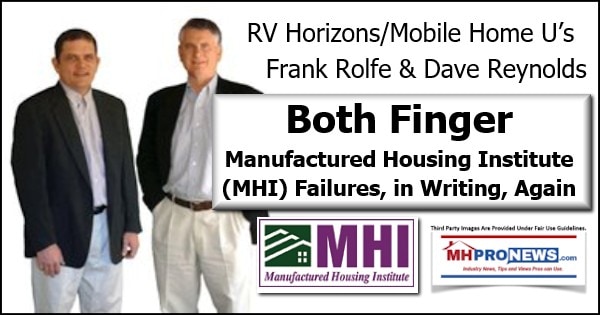
It has been a while since we’ve done a focus article on Frank Rolfe and Dave Reynolds, partners in RV Horizons, Mobile Home University, and other manufactured home industry related ventures. Per third-party sources, RV Horizons is now financially tied to TPG Capital. TPG and RV Horizons were the subject of a recent letter from Senator Elizabeth Warren (MA-D), investigating their business practices. Frank Rolfe also featured prominently in the April 2019 attack by Last Week Tonight with John Oliver errantly named “Mobile Homes” which featured the image of a modern manufactured home.
So, in spotlighting “Frank and Dave” on the Daily Business News on MHProNews, we do so with our normal ‘wheat and chaff‘ approach – separating the good (wheat) from the problematic (chaff). There are controversial things that they have said and done over the years, that MHProNews and MHLivingNews have objectively spotlighted as problematic. There are also things that they’ve said and done that are arguably useful and/or positive.
To clarify, our quoting the pair below at length, that should not be construed as an endorsement. Nor are we doing a fact check per se, as terminology is but one of the problems that they continue to arguably go awry on. Even the names of their various enterprises exemplify imprecise and inaccurately applied phrases. There have been no mobile homes built since June 15, 1976 – as the duo well know. But they continue to use terms as if “mobile home” and “manufactured homes” are interchangeable. They are not.
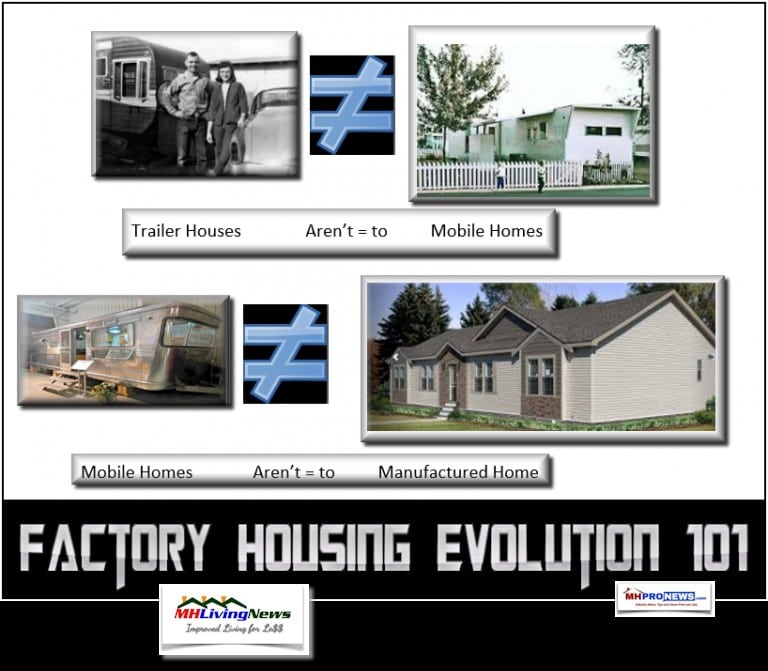
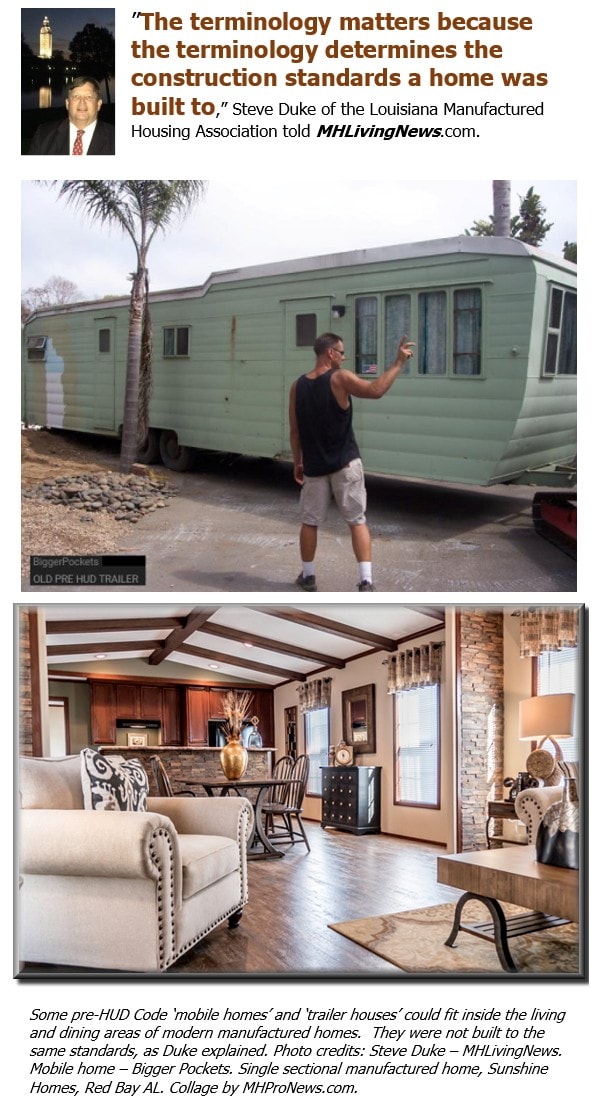
the terminology determines the
construction standards a home was
built to,” Steve Duke, LMHA.

That said, at a glance, many of the claims they make in their June, 2019 letter – which was brought to our attention by members of their team – are objectively reasonable enough. It appears that some of their comments this month are done as part of an oblique response to regulatory ‘heat’ coming from Senator Warren, legislators in Iowa, and from still more third-parties.
That said, we’ll begin with their punch line, from the very end of their lengthy column: “If you’re not a member of your state MHA then you’re making a mistake because these groups have become virtually the only representation park owners have in government today.” That’s as much of a slam on the Manufactured Housing Institute (MHI) today as it was in 2017, when Frank Rolfe said the following to MHProNews.

That said, let’s not overlook the fact that Berkshire Hathaway brands are routinely promoted by “Frank and Dave.” Nor should we overlook the role that Berkshire Chairman Warren Buffett has apparently paid in funding through so-called dark money channels MHAction, and others that have in turn been part time flame fanners who also attack the manufactured housing industry’s businesses.
The duo said: “It’s always interesting to hear what our peers are worried about, and to collectively brainstorm on the issues…” and also “HUD’s Secretary Ben Carson has been outspoken on the benefits of manufactured housing.” In doing so, they again obliquely call into question that punch-line already noted about the lack of effectiveness of MHI. Because once more, as of this morning, Carson’s potent address on manufactured housing is AWOL from MHI’s own website, even though Dr. Carson’s talk was given at an MHI meeting.
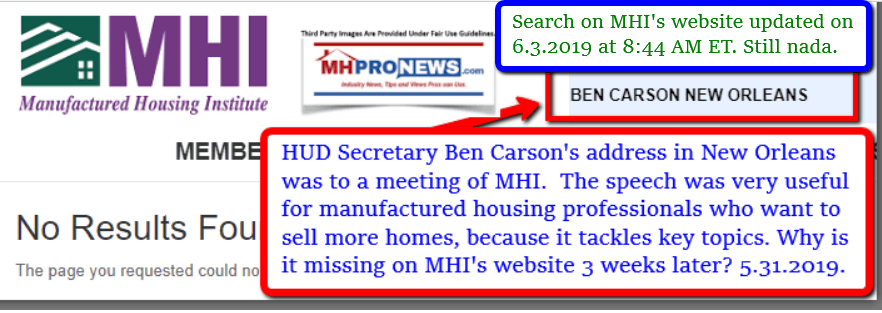
But it also can be construed as a swat against the new community trade group, NAMHCO. The National Association of Manufactured Housing Community Owners (NAMHCO) themselves have slammed MHI, whom they publicly broke ranks from.
In NAMHCO’s defense, Neal Haney made a statement about the Disney controversy – which when last checked in late May had not been corrected, thus has not gone away. That said, there is not much that one can see that NAMHCO has done beyond hiring as a lobbyist a former staffer at MHI, the very organization they broke away from? That was questionable logic at best. We’ll look at NAMHCO in the days ahead, as we are awaiting a response to some questions put to them on manufactured home community and industry issues.
With that tee up, that Rolfe himself in a video that follows this report reflects the notion that they are using improper terminology, we quote at length below the “June Mobile Home Park Investing Newsletter.” In doing so, we are editing out the numerous plugs they give to Berkshire Hathaway brands, and a few others. What remains is interesting on several levels, some of which are already noted above. All third-party images are being provided under fair use guidelines for media. The images and text are as in the original, sans advertising.

June is the first month of Summer and is also the start of the dreaded “mowing season” in mobile home parks. Why is it so dreaded? Because the average park owner has no control over the behavior of the residents regarding their lawn maintenance, and it can drive you nuts. While most park owners mow and edge the common areas and vacant lots weekly, many of our residents feel it’s OK to get out the old lawn mower once a month. As a result, the park manager is put in the unenviable position of having to be referee of which lawns have to be “forced mowed” when our mowers arrive (a “forced mow” is when the park’s lawn company mows the resident’s yard due to excessive height and then the park bills the customer for it). Of course, this typically results in an argument by the homeowner that “my yard wasn’t that bad”. At some point, the park owner thinks “maybe I should just mow all the yards every week and include that in the rent”. The problem with that concept is that we are in the affordable housing business and that will result in a monthly rent increase of probably $50 per month just to break even – a huge increase. The other issue is that the residents will now collectively complain that the mower has damaged their personal items in the yard or skirting and want monetary compensation. There’s no way to win. The workable solution is to simply do what city government does – even in McMansion subdivisions. You simply let people do their thing and you set a firm guideline of what is clearly not acceptable for the good of the community and you act only in those cases to bring them back into conformance. And you back those decisions up with photographic evidence of how tall the grass and weeds are to stop any potential argument from the homeowner (or judge if it ever came to that). While Summer is the best time of the year for mobile home sales and rentals (equivalent to the retail industry’s Christmas season) many park owners secretly smile when freezing temperatures return and the grass turns brown.

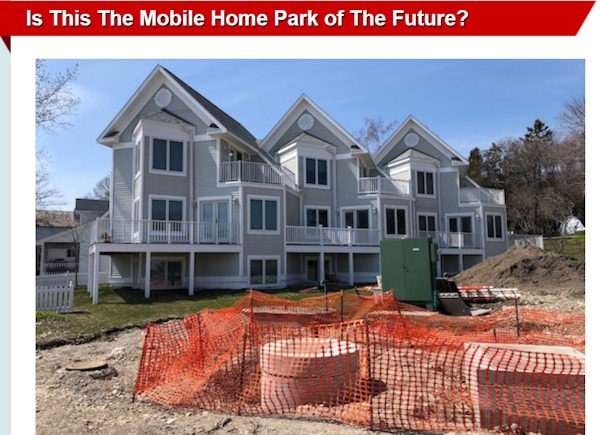
The average American never pays attention to it, but mobile home parks share a common trait with the animal kingdom: they are becoming an endangered species. But the culprit is not climate change or the removal of the rainforest. Instead it’s an environment in which land values are constantly increasing while park owners are criticized for raising rents (or in the case of four states with rent control, stopping rent increases altogether). Contrary to what some people may think, without increasing rents, mobile home parks become other uses, such as the one pictured above. Why is this occurring?
Why mobile home parks are easy targets for re-development
In many cities, mobile home parks are the most valuable development site in the entire market. Why? Because most cities will do whatever it takes to get the mobile home park torn down. They have this motivation for two reasons: 1) the local residents unfairly blame the mobile home park for all local crime (which studies have shown is actually the Class C and lower apartment buildings) and 2) mobile home parks cost city government huge amounts of money in school tuition vs. actual property tax income (which is true in many cases). Since the city wants the mobile home park to be gone, they are willing to grant any type of zoning the builder applicant desires, such as ultra-high-density apartment (which they won’t allow anywhere else). Want to obtain once-ion-a-lifetime zoning for your development? Just buy a mobile home park and propose to tear it down.
How higher rents are essential to keep parks alive
There’s a misguided narrative in America right now that would suggest that the solution to all social ills is to hamper the ability to increase rents. Advocates try to do this politically (although it has failed miserably to date) or through cajoling park owners that higher rents are evil and sending them nasty letters. What these folks fail to grasp is that higher rents are actually the only way to keep parks in business. Without higher rents, the owner cannot afford to make the capital upgrades that most parks need for the next half-century. And, of course, without higher rents there are just too many other uses for the land that are more attractive. Case in point, the average apartment rent in the U.S. is $1,270 per month, while the average mobile home park rent is only $280 – about $1,000 per month different. That’s why so many mobile home parks are being torn down and made into apartments.
Should mobile home parks be subsidized by the U.S. government – just as apartments are?
Regarding the argument that higher rents will ultimately price the most marginal residents out of the housing market, the same argument could be made for apartment rents, which have risen far faster and higher than mobile home parks could ever accomplish. Yet there’s no push back from housing advocates because the poorer tenants are kept afloat through Section 8 – HUD’s assistance program that pays roughly 80% of the rent in many cases. So why should the government deny all assistance to mobile home park residents who are marginal? Good question. HUD passed a program of support to mobile home park residents a while back but then failed to enact it – so I guess you’d have to give them a call to find out the reasons. Perhaps the biggest is simply that the program – by HUD’s own admission – has no room for new customers.
Could tax breaks hold the key?
A few years ago Congressman Keith Ellison proposed a tax incentive that gives the mobile home park owner attractive tax breaks if they keep the property in that same use post-sale. Many people agreed with the simplicity of the concept (effectively reducing capital gains tax if the park is not re-developed) but nobody felt the issue was important enough to even vote on it. That’s a shame, as it might have saved some of the parks – and homes of thousands of residents – that have fallen under the wrecking ball since the idea was first bounced around.
What other things could be done to make owning a park more attractive?
When you add together city hostility, the absence of government assistance, and the constant negative pressure of special interest groups, it’s a wonder that more parks are not torn down than the current pace. We are not advocating that all Americans should install a bumper sticker that says “Hug a Park Owner” but there definitely needs to be more media narratives on the positive side of the industry and the important role that park owners play in solving the affordable housing crisis. It’s only fair.
Conclusion
Mobile home parks are the only workable solution to the U.S. affordable housing crisis. But they are a finite commodity and it’s dwindling every month. Politicians, media and the U.S. public need to understand the factors at play and support the industry like never before. Mobile home parks are limited in number and every time one is re-developed another one does not take its place. While many may argue over the importance of the Australian Water Frog, this is one endangered species that will result in huge ramifications for millions of Americans.
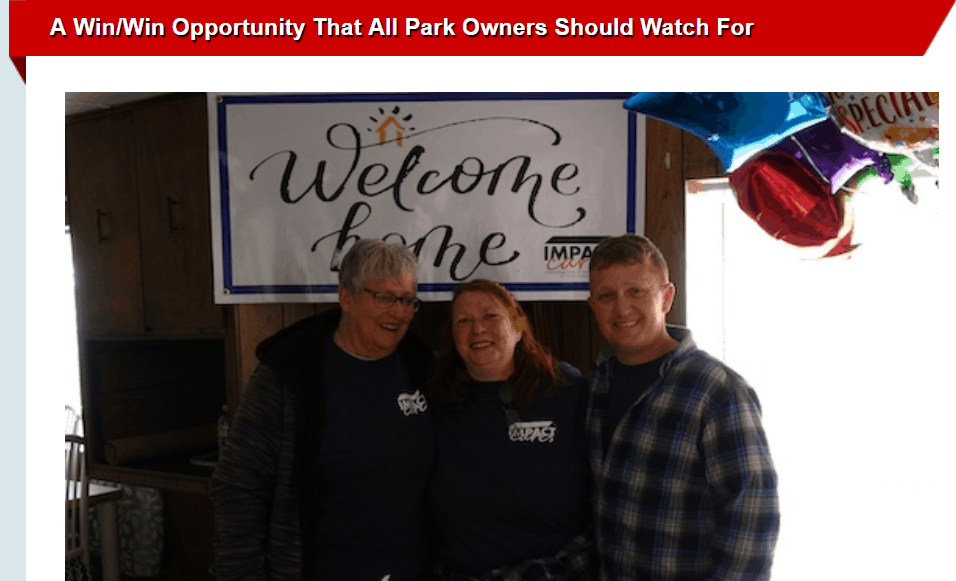
Patricia and her husband had fallen on hard times and had spent the previous eight months living in their van. Pat explained that during their time without a home they boiled water from streams in the mountains to make it drinkable and Pat worked odd jobs to put food on the table. Her husband is ill and disabled. They always set money aside, and eventually were able to save up the down payment on a small travel trailer and placed it on a lot in our property in Grants, New Mexico. For eight years they were a model resident, never being late on the rent and always being a good neighbor. But it was extremely difficult for them to live full-time in a tiny RV, particularly with a disability.
Recently a used mobile home became available in the property, with a nominal value. Our manager – and everyone in the community – had an idea. What if they could remodel the home and put Pat and her husband in it? To us, it was a great idea. Here we had a resident in need, who had been a pillar of our community, and we had the opportunity to give back to them, as well as to ignite the spirit of giving in others. Our manager, other company associates, and friends from their church contributed money and labor to remodel the home and to fully furnish it. Her pastor bought a new flat screen television – the generosity was contagious.
When Pat and her husband were presented with their new home, everyone present was crying. Statements were overheard “I have never felt this good before!” and “this shows there are still good people in the world!”. With building a strong sense of community an important mission of all park owners, it’s this type of project that really ignites this concept. Time magazine wrote a glowing article on the mobile home park industry a couple years ago that said that “mobile home parks are like gated communities of the less affluent”. They raved about how the bonds between residents were strong and highly important to a healthy life. We completely agree and were happy to help push this concept forward in our property.
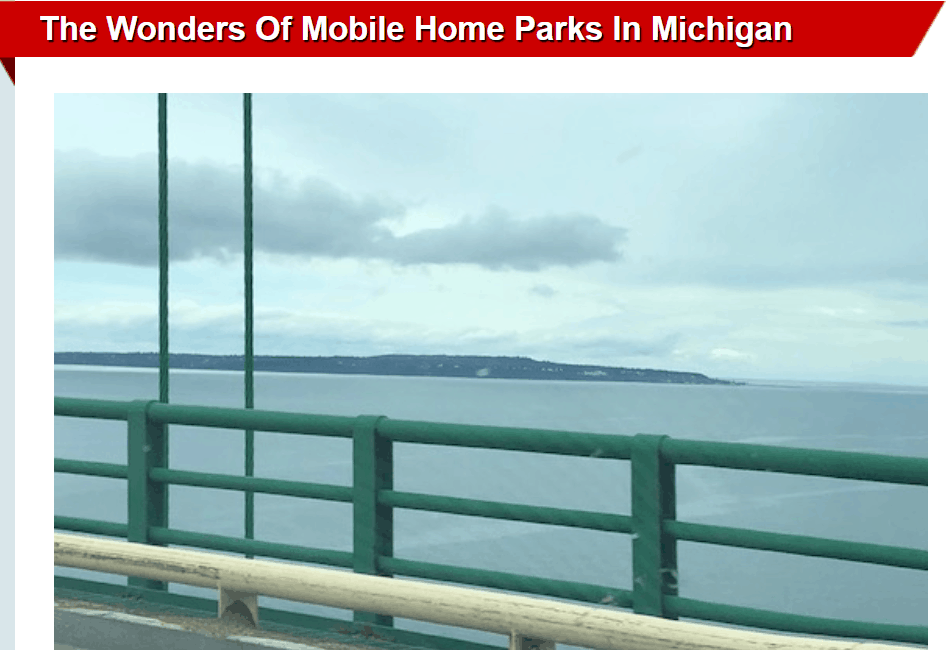
We have always been big fans of Michigan – even back when few people were in the 1990s. We knew that this is a great place for the housing industry and have done extremely well there. So what makes mobile home parks so successful in Michigan?
Why most people don’t understand Michigan to begin with (hint: the impact of Detroit)
The first issue is why anybody would not be attracted to Michigan in the first place. The answer, of course, is the collapse of the auto industry beginning in 1970s and the perceived impact on Detroit. For many years, the simple mention of Michigan struck terror into the heart of park buyers and lenders because they just couldn’t get the visual image of inner-city Detroit out of their mind. But that’s a ridiculous situation as the state is vase and Detroit is just one tiny piece of it. The Michigan that we know and invest in has zero exposure to the auto industry and is on the whole other side of the state. Cities like Ann Arbor and Traverse City have never had a notable recession and are economic powerhouses far removed from the world of Henry Ford.
Why it has a robust economy: a review of the state’s stats
Let’s review the stats for the State of Michigan today:
- The unemployment rate is 4%.
- The median home price is $151,700.
- The average two-bedroom apartment rent is $915 per month.
- There are 30 of the Fortune 500 companies based there.
- There are 210,957 millionaires that live there.
Does that sound weak to you? And that’s despite the decline of Detroit, which was once the world center of automobile manufacturing.
Why it is a great market for mobile home parks
We have always said that to have successful mobile home parks you have to have a housing “contrast” – do have demand for affordable housing you need to have expensive housing. And Michigan has expensive housing. This may be due to economic factors as well as simply supply & demand as there is not a vast amount of buildable land in an area if water features and significant topography. On top of that, the customer base in Michigan is just wired different, with outstanding collections and pride-of-ownership that is only found in the northern states. The final unique feature to Michigan – although it’s growing throughout the U.S. – is higher rents. The typical lot rent in most of Michigan is $300 to $500 per month, and that’s even in lower population market. At that rent levels, it makes mobile home parks very valuable and worthy of significant time and effort to turn them around.
Conclusion
We are huge fans of the “Great Lakes State”. We own a significant number of mobile home parks there and really enjoy the quality of the product and the customer. If you don’t understand the true status of Michigan, we urge you to study it. And don’t forget that western Michigan is a great place to visit this Summer, with some of the best beaches in the U.S. and fantastic scenery.
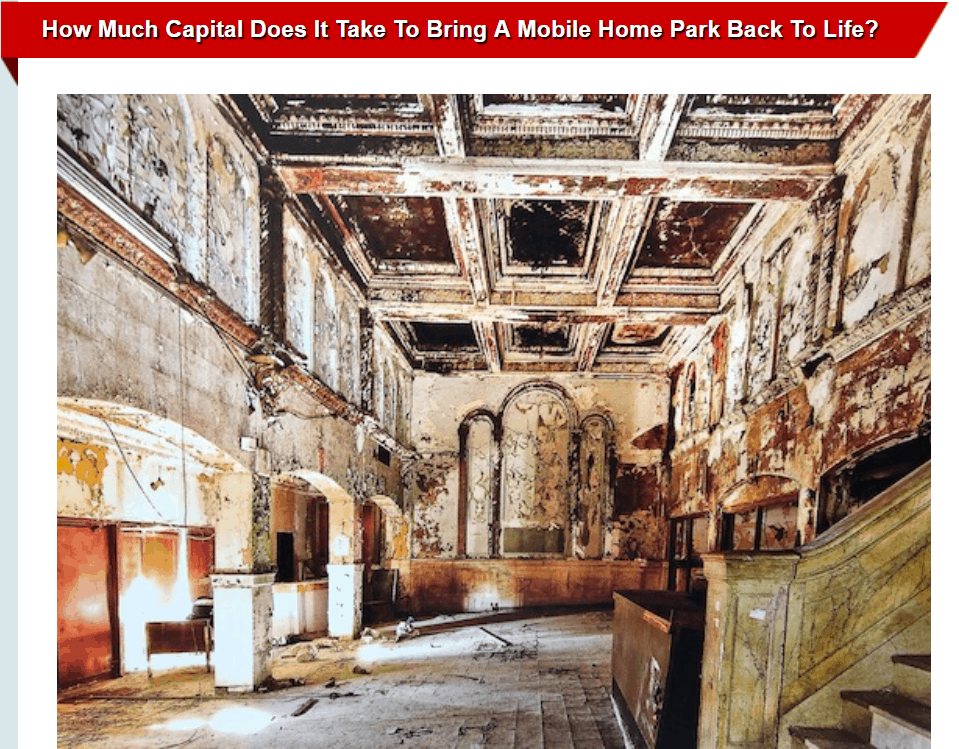
We have spent that past 25+ years bringing old mobile home parks back to life. It’s a passion that more American investors are starting to share. Re-positioning an old mobile home park for the new century typically requires capital investment. So how much does it really cost?
Big dollar items
When bringing a mobile home park back to life, there are some really big dollar projects that are required in some properties. Here is what those are and roughly what they cost (of course, the cost is dependent on many factors ranging from size of property to number of vendors and even weather considerations):
- Roads. This can include everything from pothole repair to asphalt skim coat to full road base and asphalt replacement ($10,000 to $250,000+)
- Utility line replacement. This can include water, sewer, power or gas line upgrades ($100,000+)
- Parking pads. These may be gravel, asphalt or concrete 20’ x 20’ squares ($50,000 to $100,000+)
- Park-owned home renovations. Our average cost is $4,000 per home, so it’s completely contingent on the number of park-owned homes and the condition ($20,000 to $100,000+)
Medium dollar items
- Tree trimming. This can range from a single dead tree to a virtual forest ($5,000 to $50,000+)
- Restoration of the old mom and pop residence. These old homes typically have a ton of deferred maintenance including roofs, foundations, flooring and HVAC ($10,000 to $20,000+)
- Restoration of the old clubhouse and/or pool. Basically taking the old shell of a building and installing new flooring and painting, or bringing the old pool back to life ($5,000 to $30,000+)
- Large amount of fence installation. Many properties have large-scale privacy fencing separating the park from neighboring uses, or chain link fence on the lots ($5,000 to 15,000+)
- Scrapping of obsolete park-owned homes. Sometimes mom & pop owners don’t take the time and money to remove vacated structures that are a detriment to the park ($4,000 to $20,000+)
- Painting and skirting select homes. The park owner has to act as the catalyst even on the homes they don’t own, mostly taking care of home renovation projects for residents who are financially incapable of getting the job done ($5,000 to $15,000+)
Smaller dollar items
- Entry fencing. Costing about $10 per linear foot, this would typically be three-rail white vinyl fence that is used to make our entry more attractive ($2,000 to $4,000)
- Entry signage. This is the nice sign at the front of the property that sets the first impression for the residents and the community at large ($1,000 to $2,000)
- Interior signage. A continuation of the entry sign design, these include all stop signs and street signs and are typically based on utilizing white vinyl posts and caps ($1,000 to $2,000)
- Marketing materials. These range from banners to pennant streamers on homes, as well as “for rent” signs for windows and yards and brochures ($500 to $1,000)
- Seasonal color. These are the flower beds at your entry sign and often the office ($100 to $500)
- Debris removal. This would include the initial roll-off dumpsters and labor ($1,500 to $3,000)
- Mowing. This would be the initial reclaiming of the property including all common areas, vacant lots, removal of grass from parking pads and edging of streets. ($2,000+)
Free items that still have a huge impact
- Enacting professional management. Residents really appreciate a manager who is fair to everyone and shows no favorites, as well as consistent in enacting systems (collections and rules enforcement)
- A cheerful manager that cares about the residents. Happiness and enthusiasm is contagious, and this is a very powerful force in building a successful resident base.
- Building a sense of community. The relationships between our residents and the resulting support network are the bedrock of one of our biggest amenities. Time magazine noted this in their article a couple years ago titled “The Home of the Future” in which they raved about resident relationships in mobile home parks. Owners create this with the inclusion of a friendly manager, as well as treating residents with respect and enabling relationship-building by bringing “gathering spaces” (like picnic tables and playgrounds) back on-line.
Conclusion
Bringing old mobile home parks back to life costs money. It also requires smart planning and persistence. It’s not as simple as some people think, and it works to the benefit of all residents. The net effect is a gain for society and a resulting financial success.
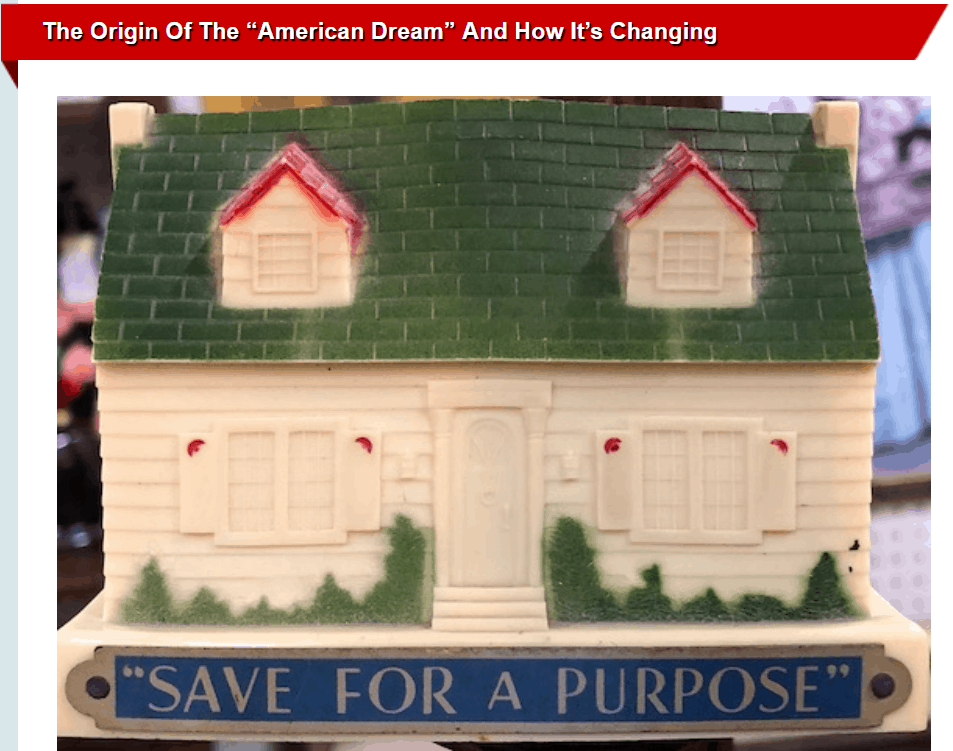
What is the “American Dream”?
According to Wikipedia, “the American Dream is a national ethos of the United States, the set of ideals (democracy, rights, liberty, opportunity and equality) in which freedom includes the opportunity for prosperity and success, as well as an upward social mobility for the family and children, achieved through hard work in a society with few barriers. In the definition of the “American Dream” by James Truslow Adams in 1931, “life should be better and richer and fuller for everyone, with opportunity for each according to ability or achievement” regardless of social class or circumstances of birth. The American Dream is rooted in the Declaration of Independence, which proclaims that “all men are created equal” with the right to “life, liberty and the pursuit of happiness.”
One big part of the “American Dream” has always been the ability to be a homeowner. When you ask the average American “what’s the American Dream?” they will always answer “owning your own home”. That’s been reflected in American culture for over a hundred years, even in small items like the piggy bank from the 1930s – shown above – that references that saving for your home down-payment is your #1 priority. So how has that opinion changed over time, and where is it heading?
Rates of home ownership increased for decades
The rate of home ownership in 1960 was 65.2%. It increased steadily to 69% by 2004 – the peak year of home ownership in American history. At that time, it seemed as though the rate would continuously inch upward until the ownership rate was ultimately nearly 100% — with the only renters being those who were saving up their down-payment for the home purchase.
And consider the financial performance during that period
In 1960, the average home in the U.S. cost $11,900. Inflation adjusted, that amount in 1960 is the same as $102,737 today. Yet the average home cost today in the U.S. is nearly $200,000, which is twice that of the rate of inflation. That would rank single-family homes as one of the most successful investment models of the 20th century. So were home buyers really chasing the goal of owning their residence, or were they merely following a traditional investment path?
But now things have changed
However, since the single-family home mortgage bubble burst and the Great Recession of 2007 began, the current rate of home ownership is 64.2%, which was lower than 1960. This would have been considered impossible to “American Dream” purists. But, of course, those who coined the phrase “American Dream” were born in the 19th century.
Unlocking the driver to home ownership
So the key question is: how much of home ownership is based on the desire to not be a renter, and how much of it is simply an investment strategy? And is the rate of home ownership declining simply because Americans are no longer convinced that homes are a great investment based on the financial performance and they prefer the freedom of renting over ownership? In that case, will this trajectory change in the years ahead?
What the “American Dream” of the future may look like
If younger generations do not share the “American Dream” and fail to believe in the investment strategy of a stick-built house or the necessity to own one simply because that’s what they’ve been told, then what happens? That’s an issue that builders and realtors across America are beginning to ponder. As the Baby Boomers (those born between 1946 and 1964) retire at the rate of 10,000 per day and downsize, who will be buying their homes? Will it be the end user, or companies that specifically buy these homes merely as rental property?
The impact of this theory on mobile home price appreciation arguments
One constant complaint by many people is that mobile homes do not appreciate – that they follow the same path of an automobile that declines in value annually because of age. But this complaint is only valid if you believe that home ownership is simply about the investment model. At the other end of the spectrum, you could also argue that the mobile home owner is smarter than the single family investor, since they spend a far lower amount monthly on their housing, and can invest the difference in other things that gain in value, or hold value, better than a dwelling.
The future is all about flexibility
Mobile home parks offer the ultimate in flexibility. The resident rents the land and has an investment as low as $2,000 or so in a used home up to $40,000 in a new one (about 80% to 99% less than stick-built home prices). And they can still be a homeowner without gambling on the single-family home business model. This also hedges their risk on mobility, as the stick-built owner is burdened by selling their gigantic investment that can sometimes take years, while the mobile home owner has a much smaller risk and a more robust market of those needing affordable housing. While most Americans have virtually all of their net worth invested in their home, mobile home owners do not have all their eggs in one basket.
Conclusion
Home ownership and price appreciation are rapidly evolving. Mobile home parks strike a good middle ground that offers low cost and greater mobility and this is clearly resonating well with the new America as demand has never been higher.
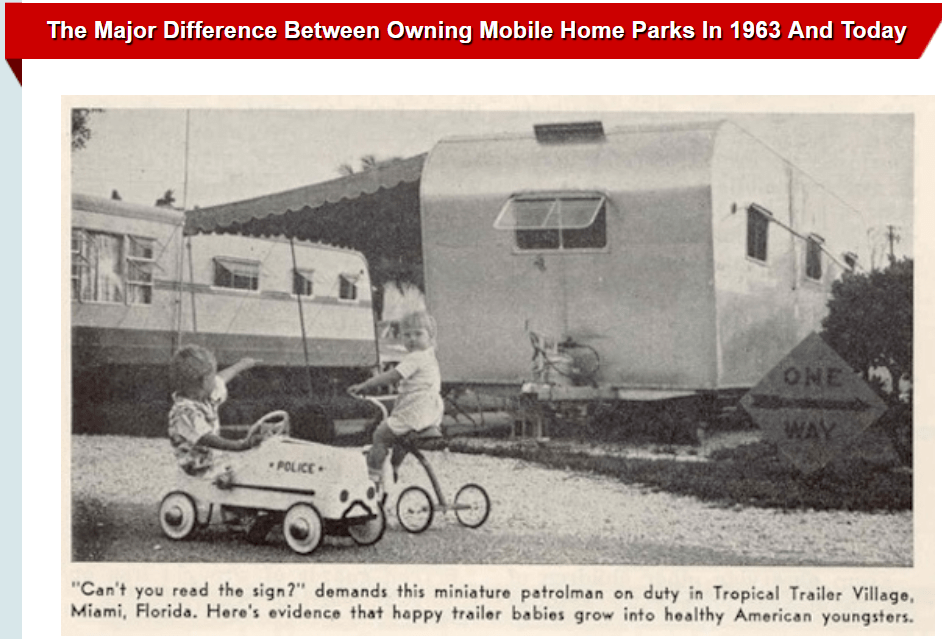
We were recently able to interview a mobile home park owner from 1963, who is among the oldest living members of a state association. And we were stunned by the major difference between park ownership back then versus today. Apparently, the hardest thing a park owner had to a half-century ago was to obtain financing. And that fact ties many things together in the industry today.
The difficulty of financing in 1963
The owner told me that they approached every bank in the local era and were almost immediately turned down. Just when it looked like financing was unattainable, they ran into a loan officer that was a Mason, and they agreed to take a look at the deal. It was the affiliation of both men with the Masonic Lodge that made the loan possible.
In contrast to today
Mobile home parks have the lowest – or second lowest – default rate of any commercial loan year after year. As a result, banks love the loan product today. The modern park purchaser has access to regular bank loans as well as CMBS “conduit” debt and even Fannie Mae and Freddie Mac “Agency” debt. In fact, there has never been a better climate to obtain a mobile home park loan in.
Why this ties many facts together
There are two main byproducts of this past difficulty in obtaining debt that are demonstrated in today’s industry:
- The abundance of seller financing. Since most mobile home park owners of the 1960s had a terrible time obtaining a loan, then that’s probably the reason that so many mobile home park owners are willing to carry the financing – they just assume that getting bank debt is impossible.
- Why there were so many parks built in the HUD program of the 1960s. There was a huge mobile home park financing program offered by HUD in the late 1960s and it provided up to 97% LTV at a low interest rate. Since it was so difficult to borrow money back then, this explains why there were so many parks constructed under this program.
Conclusion
Today’s mobile home park owners take for granted the ability to easily obtain bank debt. But it was not always the case, and the owners of the 1960s had this as one of their primary concerns. Since real estate investing is based upon the sensible leverage, it’s a miracle that the mobile home park industry was able to get off the ground back in its formative stage. Once again the “Greatest Generation” defied the odds and blazed the trails that we all take for granted today.
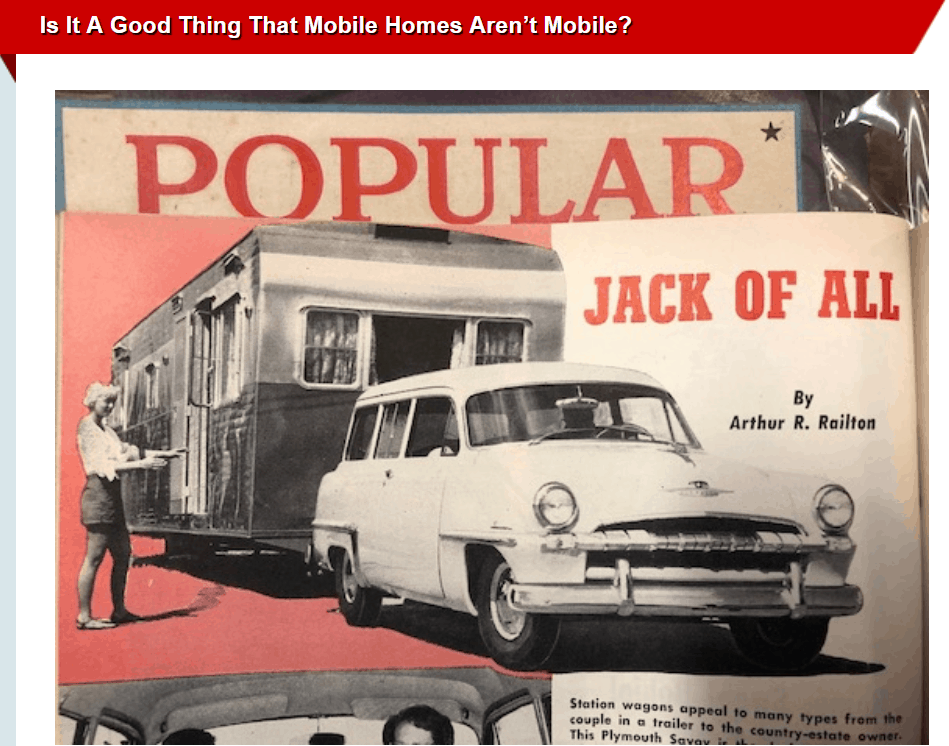
The media often makes the case that it’s a terrible thing that mobile homes aren’t really mobile. It’s true that 98% never move a second time, and that’s probably the result of the high cost to do so (around $5,000) coupled with the simple reality that an older home is not really road-worthy. Frank is often criticized for his economics lesson for Bloomberg reporter that mobile home park residents are like customers chained to their booths in a Waffle House, but that’s not necessarily a bad thing, just as seat belts restrict your movement in a car but have many positive attributes. So what are the benefits of mobile homes not being mobile?
The capability of having a larger home
Let’s not forget that the reason that it costs $5,000 to move a mobile home is that they are huge. They were able to transform from 8’ width to up to 18’ width, and 38’ length to as much as 100’ length, thanks to one-time moving permits. This loophole was found by Selby Industries in the 1960s – namely that the Highway Department would allow things to be moved down the highway that were bigger than an RV if you used professional drivers and rigs to handle that wide load. What do you call a mobile home that’s easy to move anytime you want? It’s called an RV. If that’s what you want, there’s a dealership down the highway that will be happy to sell you something that does not exceed 400 square feet typically – while mobile homes are around 1,000 square feet in many cases.
Greater sense of community with stable residents
One of the most important amenities for mobile home park residents according to Time magazine’s article “The Home of the Future” is the sense of community that mobile home park residents enjoy. In a transient situation, there is no such amenity. In RV parks – where customers come and go as they please – there are no long-term relationships forged and support network attained. Whether you’re a young person or a senior, people like to know their neighbors and feel unity with them. Lack of mobility creates this opportunity.
Closer to stick built than RV in all regards
Have you ever compared the interior of a mobile home and that of an RV? One thing you’ll immediately notice is that all RV furniture is nailed to the floor. That’s because mobile structures can’t have the attributes of stationary. Most people like conveniences and aesthetics of big kitchens, fancy bathrooms with real toilets and showers, chandeliers, and big furniture. They also like drywall, draperies and real doors. None of those are possible in homes that can move freely. The reason that mobile homes resemble stick-built structures is that they are extremely close in size and complexity – the only difference being that they arrive from a factory and not from raw lumber delivered in a field.
The ability to sell the home
One unfair criticism of the industry is that mobile homes can’t be moved so the customer is “trapped”. First of all, exactly what form of housing, besides RVs, is not “trapped” based on that definition. And what do you do in a brick house in a subdivision if you want to move? That’s right, you put a sign in the yard and you sell it. Mobile homes are no different. Each year, thousands of American households sell their mobile home and move to a new location. They don’t just abandon it or say “well, I guess I can’t take that job because I can’t move this home”. And mobile homes sell fast when priced appropriately, as the demand for affordable housing is huge and growing (just check out the active home market on MHBay and MHVillage to see for yourself).
Conclusion
The fact that mobile homes are not truly mobile is actually a benefit, not a detraction. If it was not for the complexity and expense of moving a mobile home, you would not have big sizes, nice finish-outs and the all the attributes of the American Dream, not to mention stable neighborhoods with a high sense of community.
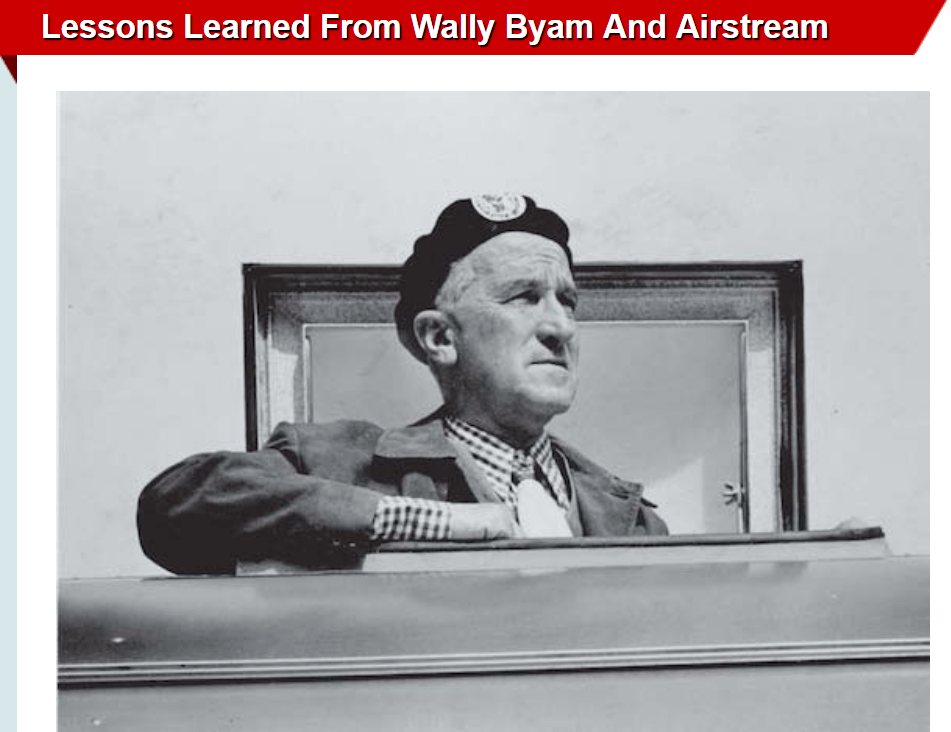
Back when the mobile home and RV product were one and the same, the Airstream would have been the wealthy relative of the modern mobile home. And the creator was Wally Byam, shown here with his Airstream trailer in 1933. Byam’s efforts at high-quality lifted the industry from mediocrity to a high level of professional design and construction, and spurred similar efforts by other notable individuals including Charles Lindbergh.
Wally Byam (1896–1962) was a mythical figure in the RV industry, who published a magazine selling “how-to” kits in the 1920s and began experimenting with building travel trailers out of Masonite in his backyard in Los Angeles. His fascination grew with this hobby, and he ultimately started producing units out of aluminum, which was a novel concept at the time. These shiny aluminum creations were much in demand by customers as they were light in weight, extremely low maintenance and had classic good looks. His greatest achievement was the introduction of the Airstream Clipper in 1936, which is still the essential design for Airstream to this day. Of the more than 400 travel trailer builders in 1936, Airstream was the sole survivor of the Depression. All other manufacturers went bankrupt during this period.
There are two main lessons to be learned from Wally Byam. The first is to always be on the quest of building the best product in the industry. That’s what allowed him to survive the Great Depression when all around him collapsed. The other is to be a master promoter of your product. Byam was known to organize Airstream tours of America and even international events, to demonstrate how great his product was. He was also a vocal RV industry proponent that led the industry following the end of World War II and the production again of RVs (the industry voluntarily ceased during the war due to a shortage of materials). Great products and great marketing are always a successful combination.
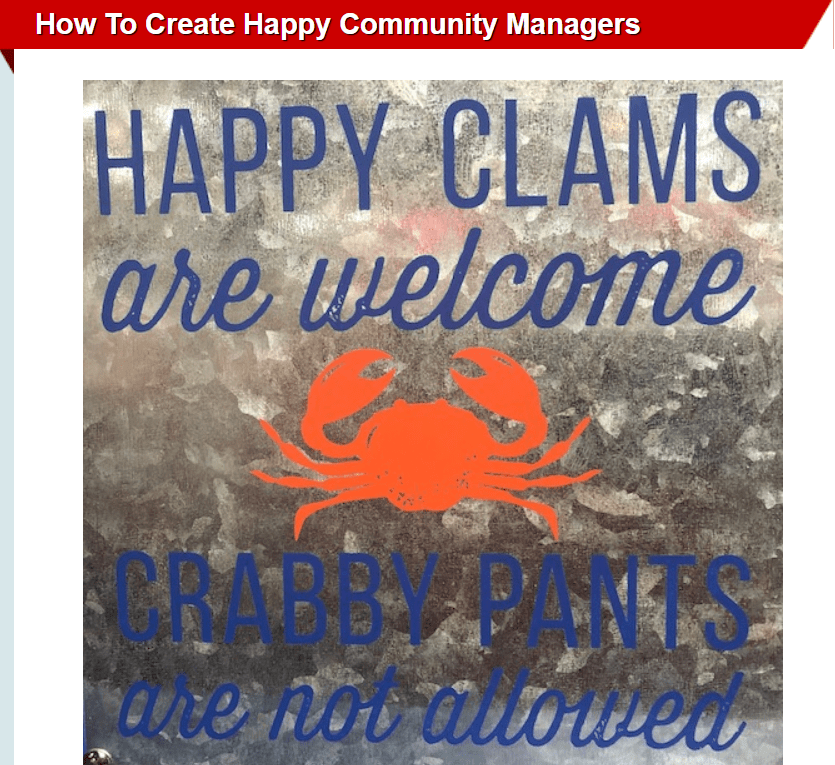
There is no powerful force in attracting and retaining residents in a mobile home park than a “happy manager”. This bright bastion of positivism puts customers at ease and infectiously spurs on their pride-of-ownership and sense of community. So how do you create happy community managers?
Choose the right person
There’s an old saying “don’t send a duck to eagle school” yet that’s what some mobile home park owners do on a regular basis. To have a happy manager you have to have the right raw ingredients. These qualities include self-confidence, a feeling of purpose, the enjoyment of dealing with people, and a cheerful personality. If the candidate is dour in the interview, then why would you expect them to be cheerful once hired? Look for potential managers that are upbeat and positive.
Train them properly
No manager is happy if they are failing at their job or lost as to their duties. The key is training. You have to show them what you expect and how to carry out those responsibilities. Only when you ask them “so are you 100% clear on every aspect of the job?” and they honestly answer “yes, I’ve got it” is your job truly done.
Treat them fairly
If you want to take the cheer out of any manager, then treat them unfairly. Nobody likes to be judged incorrectly – think back when you’ve put in the work yet are told “you don’t try at all”. Or worse when you made the basket fairly and the referee said your foot was over the line. The Golden Rule applies here. You should never consider yourself better than the manager or be quick to judge before you have the facts. Snap judgements – not supported by facts – lead to decision reversals which sour the manager and the damage cannot be undone on trust and sense of justice.
Let them know how they will be judged: eliminate uncertainty
There are only about five gauges on a mobile home park owner’s dashboard: 1) collections 2) occupancy 3) water and sewer recapture 4) property condition and 5) budget adherence. As a result, these are how a park manager should be judged. A manager that excels in these five categories should never have to worry about being scolded based on taking a “sick day” or “casual Friday” attire. When a manager feels that they are not being appreciated they start looking for different employment – and a successful manager will have no problem in finding a new home.
Don’t put them in impossible situations with residents
If you really want to create an unhappy manager, then go ahead and stick them into impossible situations with combative residents. Some owners, for example, use the on-site manager to serve all evictions paperwork when the same could be accomplished using the U.S. mail or a process server. The manager of the park needs to be a positive force and not a negative one. A good manager is able to get rules enforced and rent paid as a consultative friend wanting the resident to have a successful life – not a negative force that strikes fear in the hearts of residents. Don’t mix the two.
Conclusion
A happy manager is infectious, and spreads joy throughout the community. The happy residents tell all their friends and relatives and occupancy and collections hit 100%. The unhappy manager makes everyone miserable and never hits any targets. Happy managers are part born that way and part managed that way by the owner. Be part of the solution and not the problem.
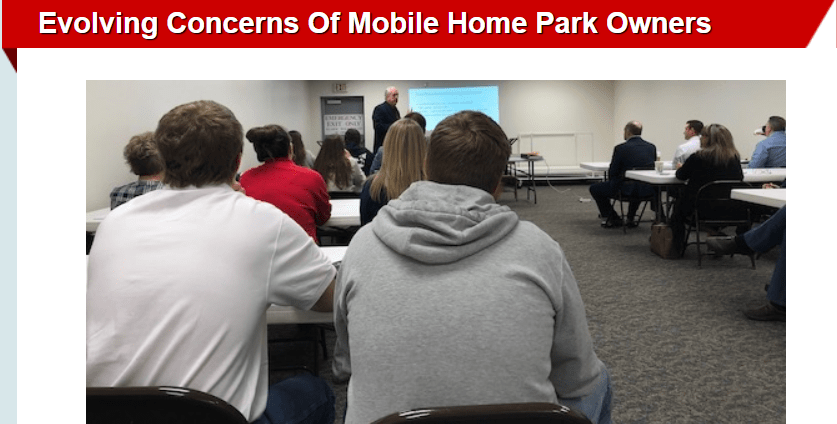
We are on the Board of the Iowa Manufactured Home Association and recently attended their annual meeting. In the room were a number of park owners, both large and small, and they had a similarity of concerns about the industry right now – topics that resonate not only in Iowa but also across the United States. Here are some of the key issues that all owners are concerned about right now, as well as our predictions on where these topics are heading.
The political climate
No park owner is happy with the unfair stereotype that mobile home park owners are trying to “take advantage” of the residents. If this were the case, U.S. rents would mirror Denver at around $750 per month, not the roughly $280 current average throughout America. However, most politicians fail to grasp the reality of the situation and a few vocal non-profits have been able to steer weaker leaders to follow their incorrect narrative. As a result, legislators are continually filing new bills (which fortunately fail consistently) that attempt to disrupt normal business practices to reward those who don’t pay or fail to conform to the rules of society in general. We see this as a cycle that has probably happened before and will ultimately dissolve as the truth about the industry’s practices in providing good quality affordable housing comes to light while the false narrative of its opponents becomes readily apparent. To quote Abraham Lincoln “you can fool all the people some of the time and some of the people all the time, but you cannot fool all the people all the time”.
Unfair media coverage
The media loves to make fun of mobile home park residents and owners. They feel that their audiences find this funny and it’s one item they can pick on that offends few of their fans (since 92% of Americans do not live in mobile homes). The media portrays all mobile home residents as “hillbillies” and “lesser beings” while stereotyping all mobile home park owners as “evil” and “opportunistic”. This is unlikely to ever end as long as audiences like this portrayal, and the media simply wants to please those that pay their bills. Of course, it’s ironic that only a few decades ago, the media loved the mobile home park industry, and portrayed the residents as highly successful and park owners as nice and supportive – that’s why Elvis Presley lived in a park in two movies (and in actuality in the farm land behind Graceland) and why “I Love Lucy” had a continual storyline of how nice the landlords were to the Ricardos.
Laws that don’t work
Park owners are tired of some of the laws out there that make no sense and cause extreme confusion and liability exposure. Take, for example, the corrupted “companion animal rules” that essentially allow the resident to claim that any animal they choose is required for emotional support by buying a certificate on eBay and thereby circumventing any restrictions on pets. We think that this odd entitlement will soon be coming to a close thanks to the airline and lodging industries, which have a problem with Americans bringing their pet donkey on a trip under the veil of emotional support. One airline has already refused to allow an “emotional support” peacock on a flight, and there has already been at least one lawsuit from an “emotional support” pit bull attacking a customer on a flight. We’re hoping that somebody starts bringing “emotional support” livestock to Congressional hearings so these same politicians can suddenly get the intelligence to end the abuse of what was intended to be an actual medical requirement from a licensed doctor.
Rent control
Thankfully, only about four states enacted rent control in the period around World War I – yes, it’s been that long since most states even considered such terrible legislation and, even then, over 90% of states said “that’s a bad idea”. However, we now have a new state that has taken the mantle of rent control: Oregon. Apparently in an attempt to stem the hike in apartment rents in Portland, the entire state is now burdened with this idiocy which even they don’t support or like (just read the interviews with mayors outside of Portland on the enactment). Rent control is flawed for many reasons, but foremost is the fact that it doesn’t work. At all. What happens is that landlords, as a result of it, don’t put any capital investment back in properties (why should they?) and, at the same time, find loopholes to get around it. It also reduces property values and – in the end – results in higher housing costs. Just look at Los Angeles and New York City as the textbook examples. And that does not even include the cost to administrate the program, which are millions of dollars per year and burden all cities with massive compliance costs that they can’t afford and have no offset in higher property tax (as values actually go down). We believe that rent control will be as popular today as it was in World War I and that few states will be dumb enough to support its flawed rationale.
Little government assistance beyond financing
HUD’s Secretary Ben Carson has been outspoken on the benefits of manufactured housing. Fannie Mae and Freddie Mac’s “Agency” debt program has been very successful, and now accounts for over 50% of total mobile home park loan volume each year. But when will their be support of the homes themselves and the customers who want to buy them. Currently, it’s only the park owners that support this cause, bringing in the homes and renting and selling them through programs administered by the home manufacturers. There’s absolutely no way that industry production can get much about 100,000 units per year (vs. around 400,000 two decades ago) unless the government participates in making loans possible for the consumer to go to a dealer and buy the homes themselves. We know the demand is there – affordable housing is in dire need virtually across America – but there can be no improvement in the number of households that attain it without greater government assistance. Unlike Section 8, these programs cost nothing to the U.S. taxpayer – so why are they so long in coming? Our opinion is that the government will tepidly explore this important topic, but in a manner that is more P.R. perception than reality and that park owners will remain the only source of significant new home purchases.
Conclusion
It’s always interesting to hear what our peers are worried about, and to collectively brainstorm on the issues, If you’re not a member of your state MHA then you’re making a mistake because these groups have become virtually the only representation park owners have in government today.
##
Let’s begin with a graphic that corrects their estimate of 400,000 new manufactured home shipments, which was actually above some 372,000 shipments that year.
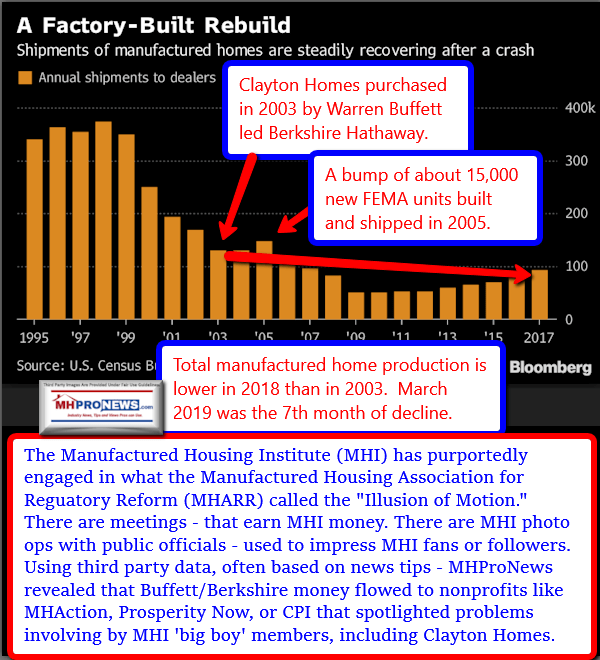
Let’s note too that this pull quote from Frank and Dave above: “There’s absolutely no way that industry production can get much about 100,000 units per year (vs. around 400,000 two decades ago) unless the government participates in making loans possible for the consumer to go to a dealer and buy the homes themselves,” is of interest for several reasons.
- Clayton Homes, 21st Mortgage Corp, MHI, Berkshire, and the GSEs are arguably a big part of the reason why there isn’t more lending than the law actually mandates. Rephrased, that’s an oblique slam at Berkshire Hathaway, one of their bigger strategic allies. It is one more reason why this is also a shot at MHI, see that closing paragraph by Frank and Dave again.
- That tee’s up several related reports from MHARR relative to the GSEs, which while it isn’t a community organization, is arguably doing more for the independent communities in the industry than MHI is doing.
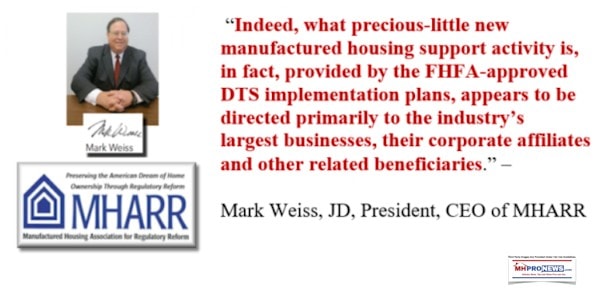
Frank and Dave also spotlighted the Oregon zoning law, which MHProNews previously reported on at the link below, and in more detail.
This pull quote from their last section by Frank and Dave is another noteworthy one: “Park owners are tired of some of the laws out there that make no sense and cause extreme confusion and liability exposure.” Because it makes a similar point, using a different example, that our publisher made last month at the link below.
Rope-a-Dope – Preserving Access to Manufactured Housing Act, Mom, Dad, & You – Masthead L. A. ‘Tony’ Kovach
There may be no one analogy that is entirely precise enough to make the point that the promoters of the Preserving Access to Manufactured Housing Act purportedly hoped to accomplish with their bill. All analogies limp at some point, but those disclosures made, let’s begin with the ‘rope and dope metaphor’ from boxing.
Frank, Dave, and Brandon Reynolds are all known to be among the regular readers on MHProNews, per our sources. Our publisher – L. A. ‘Tony’ Kovach – has noted that Frank Rolfe has routinely been willing to generously give time to speaking to industry professionals when asked, as the Inside MH videos below reflect. That deserves to be favorably mentioned (wheat).
Agree or not, terminology and controversies aside, Frank was routinely a fairly straight shooter about MHI, up until 21st Mortgage purportedly pulled his chain for blasting MHI, and they stopped commenting ‘on the record’ as readily as they did previously
Kovach said Rolfe’s content is superior in several ways to rival George Allen, as their above newsletter reflects. Frank and Dave also produced significantly better results that dwarfed Allen’s community experience. The later has toned down his attacks on the duo, perhaps because of his newfound love for MHI and their big boy backers.
That said, even these brief corrections make it clear that while Frank and Dave have useful concepts to share, they also have hyperbole, and errant points too. In some cases, one must be pretty well informed about the industry in order to separate the good from the problematic. Precisely because they are successful, they are often not closely questioned within the industry, but from outside the industry, they are routinely met with skepticism.
This recent snapshot of the controversial professionals is useful on several levels in understanding what is ailing the manufactured housing industry. See the true state of the manufactured housing industry, below the byline and notices at the close of this article.
There are good things occurring as a result of Frank, Dave and their team’s work, such a dozens of older communities being brought ‘back to life’ through private capital investments, as the RV Horizon partners outlined above.
But there are also wildly controversial and problematic videos of their own that predate the formation of MHAction, which has made the pair’s operation a target. The video dubbed “Trailer park millionaires” by the Guardian, above, has had over 1.8 million views. That smokes the viewership of anything that MHI, or much of the best that Clayton Homes has produced. So they’ve been a lightening rod for some time.
Sources in the RV Horizon’s/Mobile Home University family of brands have told MHProNews that while Frank Rolfe is not easily intimidated, he has been concerned about some of the MHAction protesters. Not the protests themselves, but allegedly some among those protestors have targeted Rolfe personally. Per sources, specific MHAction protestors have appeared to the maverick community operator to be mentally unbalanced. Perhaps at that time, Rolfe did not yet realize that money that flows from 21st and other Berkshire brands also went from Warren Buffett’s wallet via dark money channels to the NoVo Foundation, the Tides nonprofit, and onto MHAction, to protest the pair’s controversial work.
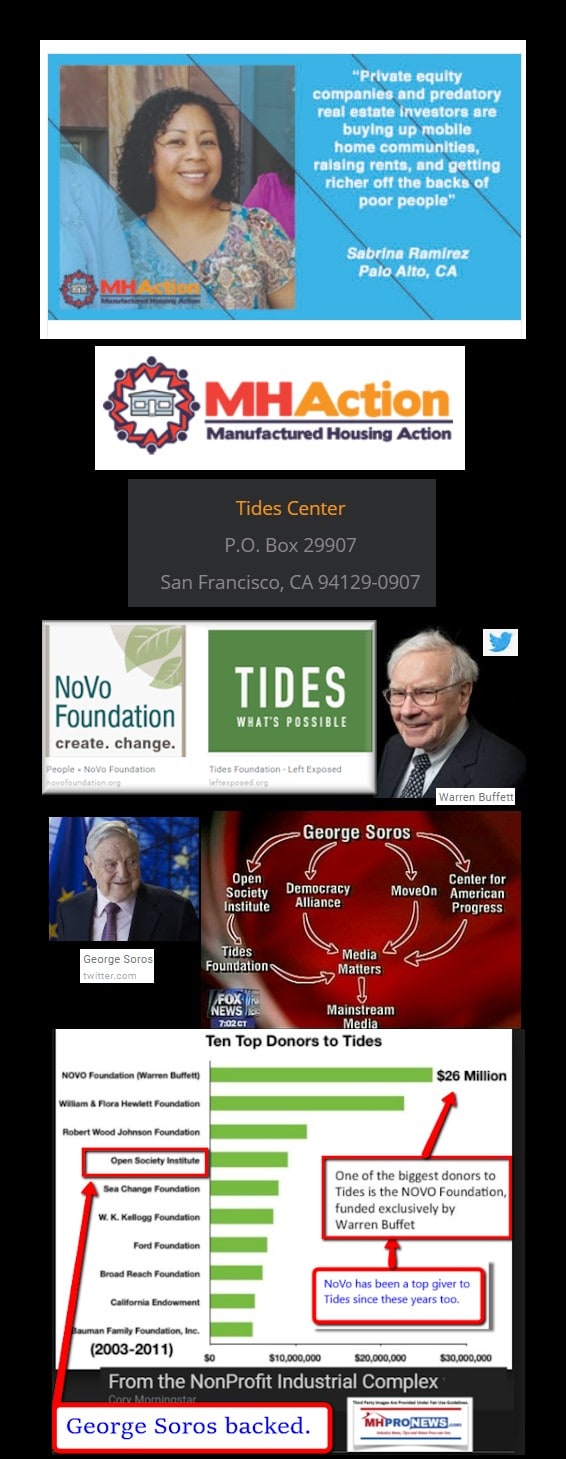
All is not as it first appears from the outside looking into MHVille, and that applies to this successful pair of manufactured home professionals.

While MHProNews has editorially debunked several of freshman Representative Alexandria Occasio-Cortez’s (AOC) policy pronouncements, this recent quote is a bit different than several of her others. “Housing is one of the most complicated policy issues that we have, period,” AOC said, per the left-of-center Common Dreams. She was speaking to a group that reportedly included manufactured home community resident-activists. “Because you have everything from city council, from how things are zoned, to state rent laws, to federal tax breaks, and all of it comes together to make a picture that all too often enriches people who are already powerful and impoverishes people who are already vulnerable, and we cannot allow that to happen anymore.”
The solution that AOC and other Democratic legislators want, said Common Dreams, was to support “Housing Justice for All, a campaign led by the Upstate Downstate Housing Alliance, a coalition of tenants, homeless people, manufactured housing residents, and advocates in New York” in their event to “pressure New York state legislators into passing a package of nine housing bills “that would supercharge rent protections in New York” by making rent control universal statewide, before current laws that affect millions of New York City residents expire on June 15.”
So, the controversial work of several manufactured home community investors that purportedly gave rise to the viral video, Mobile Homes, by John Oliver, and has sparked an inquiry by Senator Elizabeth Warren (MA-D) that specifically targeted RV Horizon’s and others is fueling calls for rent control and other forms of regulatory oversight.
Some of the poster-boys for manufactured housing: Warren Buffett, Kevin Clayton, Tim Williams, and a raft of MHI connected operations that include Frank Rolfe by name in the video above, are also bringing down often harsh media criticism that fuels demand for regulatory controls. That complexity that AOC mentioned is real enough, but what she fails to say is that their solutions are not effective. Indeed, one can argue that their ‘solutions’ have paved the way for larger firms to consolidate smaller ones.
Gannett Media Exposés, MH Community Owner Moves Sparks Outrage – IEDs of Manufactured Housing
Rolfe himself has pointed the finger at MHI numerous times over the years as being part of the problem, not part of the solution.
While long-time president of historic Dick Moore Housing opens in the video below, much of the commentary is by Frank Rolfe. Rolfe candidly laid out the case why Preserving Access to Manufactured Housing Act would never pass. Rolfe thought it a waste of time. That too is a not subtle slam on the backers of the bill, which was led by MHI, Clayton Homes, and 21st Mortgage Corp.
This is all part of the complex picture of manufactured housing today. Good deeds are overshadowed by problematic ones, and the industry finds itself at sub-100,000 new manufactured home shipments as a consequence. In a lengthy look at Preserving Access, our publisher who in principle backed the concept, called it in hindsight a “Rope-a-Dope” measure, designed to wear out community owners and retailers, several of which sold out to big boy firms, or folded.
Rope-a-Dope – Preserving Access to Manufactured Housing Act, Mom, Dad, & You – Masthead L. A. ‘Tony’ Kovach
There may be no one analogy that is entirely precise enough to make the point that the promoters of the Preserving Access to Manufactured Housing Act purportedly hoped to accomplish with their bill. All analogies limp at some point, but those disclosures made, let’s begin with the ‘rope and dope metaphor’ from boxing.
Quoting Frank and Dave, from their column above, “Park owners are tired of some of the laws out there that make no sense and cause extreme confusion and liability exposure.” The charge for those laws that are confusing and make no sense have been led by candidates who garnered the support of Warren Buffett, or prominent MHI member Nathan Smith, of SSK Communities. Smith is a high prolife Democratic party leader in his home state of Kentucky, who backed Secretary Hillary Clinton’s campaign, that promised to strengthen Dodd-Frank. Smith was blasted by Rolfe in the quote below.
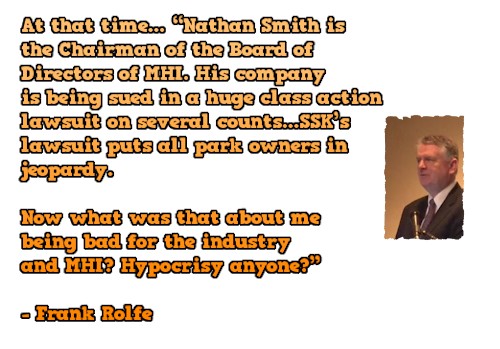
Indeed, the mainstream news videos on the page linked here make it clear that Rolfe was not exaggerating his concerns over the harm done by Smith and SSK Communities to the image of manufactured housing.
Some of the most prominent people in manufactured housing are what a perspective manufactured housing industry investor deemed ‘black hat operators’ in a conversation with MHProNews. While MHI has white hat firms too, it is the black hats that spark the onerous legislation that the white hats are left to struggle under.
Rolfe and Dave are arguably correct in his ongoing, if oblique, attack on MHI. But it is worth noting that a non-community operation is trying to do something about it that would be good for affordable housing seekers, manufactured homeowners, and the industry’s independents. See that report linked here.
That’s this Monday, Monday look at manufactured home “Industry News, Tips, and Views Pros Can Use,” © where “We Provide, You Decide.” © ## (News, analysis, and commentary.)

NOTICE: You can get our ‘read-hot’ industry-leading emailed headline news updates, at this link here. You can join the scores who follow us on Twitter at this link. Connect on LinkedIn here.
NOTICE 2: Readers have periodically reported that they are getting a better experience when reading MHProNews on the Microsoft Edge, or Apple Safari browser than with Google’s Chrome browser. Chrome reportedly manipulates the content of a page more than the other two browsers do.
(Related Reports are further below. Third-party images and content are provided under fair use guidelines.)
1) To sign up in seconds for our MH Industry leading emailed news updates, click here.

2) To pro-vide a News Tips and/or Commentary, click the link to the left. Please note if comments are on-or-off the record, thank you.
3) Marketing, Web, Video, Consulting, Recruiting and Training Re-sources

Related Reports:
Representative Ilhan Omar’s Bill Would Regulate Manufactured Home Community Owners
Major and Continuing MHARR Accomplishments for the HUD Code Manufactured Housing Industry and Consumers of Affordable Housing | Manufactured Housing Association Regulatory Reform
Led the industry in securing the enactment of the Manufactured Housing Improvement Act of 2000 (2000 reform law), which mandates specific accountability…
Major and Continuing MHARR Accomplishments for the HUD Code Manufactured Housing Industry and Consumers of Affordable Housing | Manufactured Housing Association Regulatory Reform
Led the industry in securing the enactment of the Manufactured Housing Improvement Act of 2000 (2000 reform law), which mandates specific accountability…
“Lead, Follow … Or Get Out of The Way” | Manufactured Housing Association Regulatory Reform
The last decade-plus has not been especially kind to the manufactured housing industry and consumers of affordable housing. The 21 stCentury began with a great deal of promise for the industry and consumers alike.

























